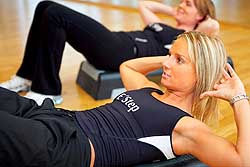Gym Vocabulary

So you've got a gym membership and you've printed a great new program off the internet. You're basically ready to rock and roll. . .
Or maybe not? Before you get your program started, this article will help you quickly and easily understand "gym talk" — the most common words used that you actually need to know.
Aerobic
While aerobics does refer to the morning TV workouts your mother or grandmother used to do in tight leotards and brightly colored sweat bands, an aerobic workout basically means that oxygen is required. Aerobic is usually associated with any cardiovascular activity which requires a prolonged amount of exercise. For instance, running on the treadmill, going for a ride on the stationary bike or going on the stepper would all be considered aerobic activities.
Circuit Training
Now this can get a bit confusing. Most gyms have a "circuit" set up, which is basically a combination of machines that are designed to be utilized in a sequence and each move is to be performed as many times as possible within a required time period, before moving on to the next machine quickly and while keeping your heart rate elevated throughout the exercise. Circuit training can be applied to any set of exercises you put together, however, the ones in the health clubs are designed to target each and every muscle group in the body.
Warm-up
A warm-up is designed to get you started on your workout by 'easing in'. A typical warm-up would be a light stroll on the treadmill or easy, five minute cycle on the bicycle, which prepares your body for the workout ahead.
Cool-down
A cool-down is performed after your workout and gives your body a chance to recover, and your heart rate to return to normal. A cool-down would be a five to ten minute stretching session, or light walk on the treadmill after your workout.
Plateau
A common term used among gym goers. When you reach a plateau in your training program, you have basically reached a stage where no further gains or changes are occurring, despite keeping everything else the same. This happens all the time and is common. To solve this problem you need to make a few changes in your program to 'shock the system'. Try upping the intensity or going for a heavier weight.
Reps
Reps or repetitions means moving the weight load through its complete range of motion in one complete move and back again to the starting position. For example, ten repetitions of a dumbbell bicep curl would be lifting the weight ten times, completing the move and returning to the starting position.
Sets
A set is a series of repetitions that are broken down into a prescribed number of repetitions. For example, three sets of ten bicep dumbbell curls, indicated as 3 x 10, would mean that you would need to complete ten repetitions of bicep curls, before having a short rest, then completing the second set, resting again and finally competing the third set. So, in essence, you will be doing thirty bicep dumbbell curls in sets of ten.

Tempo
The tempo refers to the speed of execution in the concentric phase.
Intensity
Intensity refers to how much workload you are putting on your specific muscle group, or workout duration. Intensity can be measured in "levels" 1 to 5 with 1 being easy and 5 being the most difficult.
Copyright 2007: Remedium. This article may not be copied, in whole or in part, without the written consent of Remedium.
|